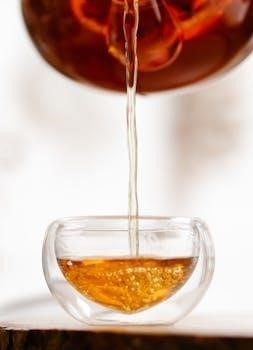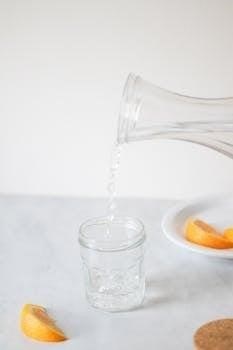
This section introduces diverticulitis, an inflammation of diverticula in the colon. Dietary management is crucial, often beginning with a low-residue diet during flare-ups. This is followed by a gradual transition to a high-fiber intake to prevent recurrences.
Understanding Diverticulitis and Diverticulosis
Diverticulosis is the presence of small, pouch-like formations called diverticula in the colon, often without symptoms. It’s a condition where these sacs develop in the large intestine’s lining. Diverticulitis, on the other hand, occurs when one or more of these diverticula become inflamed or infected, leading to pain, discomfort, and other symptoms. While diverticulosis is quite common, particularly with age, diverticulitis is a more serious complication that requires medical attention. The distinction is important because the dietary approaches vary depending on whether you have asymptomatic diverticulosis or an active flare-up of diverticulitis. Understanding this difference is key to effective management. Historically, certain foods were thought to trigger diverticulitis, but recent research has refuted this.

Dietary Approaches for Diverticulitis
Dietary strategies are vital in managing diverticulitis. Initially, a low-residue diet helps the colon rest during acute episodes. Later, a high-fiber diet is introduced for prevention and long-term management.
The Importance of a Low-Residue Diet During Acute Phases
During an acute diverticulitis flare-up, adopting a low-residue diet is crucial for reducing colon irritation and promoting healing. This diet restricts fiber intake, which means avoiding whole grains, nuts, seeds, and raw fruits and vegetables. The goal is to minimize the amount of undigested material passing through the digestive tract, allowing the inflamed areas to rest and recover. Foods like white rice, white pasta, well-cooked vegetables, and dairy products are generally recommended. This approach helps in alleviating symptoms such as pain, inflammation, and bleeding, and provides a necessary respite for the colon. Consulting with a healthcare professional is essential to determine the specific dietary plan that suits individual needs and circumstances. It is a temporary measure designed to support the body’s natural healing processes during an active inflammation.
Transitioning to a High-Fiber Diet After Acute Episodes
Once the acute phase of diverticulitis subsides, transitioning to a high-fiber diet is vital for long-term management and preventing future flare-ups. Fiber adds bulk to the stool, making it easier to pass and reducing pressure on the colon walls. This transition should be gradual, increasing fiber intake slowly to avoid discomfort such as gas and bloating. Good sources include whole grains, fruits, vegetables, and legumes. It’s important to drink plenty of water to help fiber move smoothly through the digestive system. This dietary shift aims to promote regular bowel movements and prevent the formation of new diverticula. The goal is to establish a balanced and sustainable eating pattern that supports gut health and minimizes the risk of recurrence.

Key Nutritional Considerations
This section emphasizes the importance of fiber in preventing diverticulitis recurrence; Probiotics are also discussed for their potential to improve gut health. These elements are vital for managing diverticular disease.
The Role of Fiber in Preventing Recurrences
Fiber plays a crucial role in maintaining a healthy digestive system, especially for individuals prone to diverticulitis. A diet rich in fiber can help prevent the formation of new diverticula and reduce the risk of inflammation. Fiber adds bulk to the stool, making it easier to pass and reducing pressure on the colon walls. This prevents the small pouches from becoming inflamed. It’s important to gradually increase fiber intake to avoid discomfort, while ensuring sufficient hydration is maintained. Sources of fiber include fruits, vegetables, and whole grains, all of which are vital components of a diet focused on preventing diverticulitis. Consuming adequate fiber, therefore, is a long-term strategy for managing the condition and minimizing recurrences. The correct balance of fiber can significantly contribute to gut health.
Probiotics and Their Potential Benefits for Diverticulitis
Probiotics, often referred to as “good bacteria,” are gaining attention for their potential benefits in managing diverticulitis. These live microorganisms can help restore a healthy balance of gut flora, which may play a role in reducing inflammation and improving overall digestive health. Certain strains of probiotics, such as L. casei, have been associated with a decrease in the recurrence of diverticular symptoms, particularly when used in conjunction with anti-inflammatory treatments. While research is still ongoing, incorporating probiotics into the diet or through supplements might offer a supplementary approach to managing diverticulitis. It’s important to consult with a healthcare provider before beginning probiotic use. Furthermore, the benefits may vary from person to person, and more studies are needed to confirm their effectiveness in the long term. However, probiotics show promise in supporting gut health.
Recipe Book Insights
This section explores recipe books designed for diverticulitis, focusing on healthy, flavorful meals. These books often provide options for both low-residue and high-fiber dietary needs.
Exploring Healthy and Flavorful Recipes for Diverticulitis
Finding delicious meals while managing diverticulitis can seem challenging, but many recipe books offer creative solutions. These resources showcase a wide variety of dishes that cater to both the acute phase and maintenance phases of the condition. From smooth, easy-to-digest options during flare-ups to high-fiber meals for long-term gut health, these recipe collections provide valuable guidance. They often include recipes for smoothies, soups, and simple main courses, all designed to be gentle on the digestive system. The emphasis is on using fresh, wholesome ingredients to create satisfying and nutritious meals that support healing and prevent future diverticulitis episodes. These recipes demonstrate that dietary restrictions don’t mean sacrificing flavor or enjoyment of food. Many books also offer tips on meal planning and portion control.
Examples of Diverticulitis-Friendly Dishes
Diverticulitis-friendly dishes prioritize gentle digestion and nutritional value. During acute phases, examples include smooth pureed soups like carrot or potato, creamy rice porridge, and well-cooked, skinless chicken. These options are low in residue and easy on the digestive tract. As one transitions to the maintenance phase, high-fiber foods are introduced gradually. Good examples include baked sweet potatoes, lentil stews, and oatmeal with soft fruits like berries. Recipes often feature lean proteins, such as fish or poultry, and incorporate cooked vegetables that are easy to digest. It’s important to ensure that seeds and nuts are avoided during flare-ups and introduced with caution later. The goal is to create balanced meals that are both nourishing and kind to the digestive system, aiding in recovery and preventing future issues. These dishes demonstrate that a diverticulitis-friendly diet can be varied and enjoyable.

Practical Meal Planning
This section offers structured meal plans, such as a 7-day and 14-day options, designed to help manage diverticulitis. These plans focus on gut health and dietary adjustments for recovery and maintenance.
7-Day Meal Plan Ideas for Managing Diverticulitis
This 7-day meal plan provides a structured approach to managing diverticulitis symptoms. It starts with gentle, low-residue options, like white rice and broth during the acute phase, gradually introducing fiber-rich foods as inflammation subsides. The plan emphasizes easily digestible meals, incorporating elements such as well-cooked vegetables and lean proteins. Sample meals might include oatmeal for breakfast, boiled chicken with mashed potatoes for lunch, and baked fish with steamed carrots for dinner. This plan aims to ease digestive stress and promote healing. It also includes options like yogurt and bananas, known for their gentleness on the gut. Remember to consult your healthcare provider before starting any new meal plan, particularly if you are experiencing a diverticulitis flare-up. Hydration with water and clear fluids is also a key component of this plan.
14-Day Meal Plan Options for Gut Health
A 14-day meal plan offers a more extended dietary approach for improving gut health, especially beneficial post-diverticulitis flare-ups. This plan builds upon the principles of the 7-day plan, but with greater emphasis on diversifying fiber sources. Expect gradual increases in whole grains, fruits, and vegetables, with careful monitoring for tolerance. Examples include incorporating lentil soup, quinoa salads, and a variety of berries. The plan aims to nurture the gut microbiome, promote regular bowel movements, and reduce the risk of future diverticulitis episodes. Meals should be balanced, including lean proteins, healthy fats, and complex carbohydrates. It is not a strict diet, but a guide to a more gut-friendly way of eating. Careful meal planning and food preparation are key components of this 14-day approach. Adjust portion sizes and meal timings to suit personal needs and preferences.

Additional Resources
Explore online resources from reputable health organizations for more on diverticulitis and diet. Look for books and articles that offer detailed dietary guidelines and recipe ideas for managing this condition.
Where to Find More Information on Diverticulitis and Diet
Seeking reliable information about diverticulitis and dietary management is vital for effective self-care. You can find valuable resources on websites of reputable health organizations like the National Institute of Diabetes and Digestive and Kidney Diseases. Medical journals often publish research on the latest findings regarding diverticulitis and its dietary management. Furthermore, many hospitals and university health systems provide online guides and information for patients. Look for credible sources that offer evidence-based recommendations. Consider searching for books and articles written by registered dietitians or gastroenterologists. These resources can give you comprehensive information on the best dietary practices for preventing and managing diverticulitis. You can also explore online patient forums and support groups, but always verify information from these sources with your doctor.